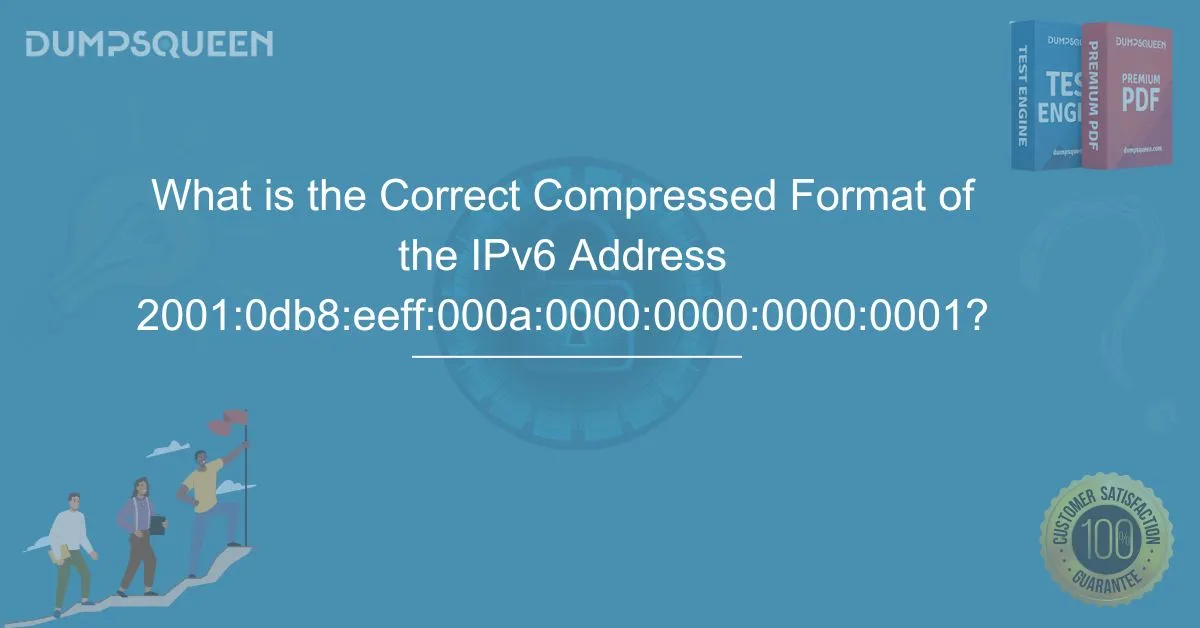Introduction
The evolution of the internet has led to a significant shift from IPv4 to IPv6, providing a larger address space and improved networking capabilities. IPv6 addresses are 128-bit hexadecimal values, often appearing lengthy and complex. To make these addresses more readable, IPv6 includes compression techniques that reduce redundant notations. Understanding how IPv6 addresses can be shortened is essential for network administrators, IT professionals, and students learning about modern networking systems. In this article, we will explore how to correctly compress the IPv6 address 2001:0db8:eeff:000a:0000:0000:0000:0001, providing a detailed explanation of the process, its importance, and real-world applications.
Understanding IPv6 Address Structure
IPv6 addresses consist of eight groups, each containing four hexadecimal digits separated by colons. Unlike IPv4, which has a limited number of possible addresses, IPv6 provides a vastly expanded address space, ensuring long-term scalability. However, the extended length of IPv6 addresses can sometimes make them difficult to read and manage. This is where compression techniques become useful, allowing for a more efficient and human-friendly representation of these addresses without altering their functionality.
The full IPv6 address we are working with is:
2001:0db8:eeff:000a:0000:0000:0000:0001This address follows the standard IPv6 format but includes multiple zero sections that can be compressed for better readability and ease of use.
How IPv6 Compression Works
IPv6 compression follows specific rules that simplify the representation of addresses without changing their value. There are two main techniques used in IPv6 address compression:
-
Leading Zero Suppression – Any leading zeros in a four-character block can be omitted. For example,
000abecomesaand0db8becomesdb8. -
Zero Compression (::) – Consecutive groups of zeros can be replaced with a double colon (
::). This can only be applied once in an address to avoid ambiguity.
Applying these techniques makes IPv6 addresses shorter and more convenient for manual entry and configuration.
Compressing the IPv6 Address 2001:0db8:eeff:000a:0000:0000:0000:0001
Now, let’s apply the compression rules step by step:
Step 1: Removing Leading Zeros
We start by removing any leading zeros from each block of the address:
-
2001:0db8:eeff:000a:0000:0000:0000:0001 -
After removing leading zeros:
2001:db8:eeff:a:0:0:0:1
Step 2: Applying Zero Compression (::)
Next, we identify the longest contiguous sequence of zero blocks (0:0:0). According to IPv6 compression rules, the longest sequence of consecutive zero groups can be replaced with ::.
-
Address before compression:
2001:db8:eeff:a:0:0:0:1 -
Replacing
0:0:0with::gives us the final compressed format:
2001:db8:eeff:a::1This is the correct compressed format of the IPv6 address 2001:0db8:eeff:000a:0000:0000:0000:0001.
Why IPv6 Compression Matters
IPv6 compression is an essential technique that provides multiple benefits:
-
Improved Readability – Shorter addresses are easier to understand and use in networking configurations.
-
Reduced Errors – When manually entering an IPv6 address, the risk of typographical errors decreases with shorter representations.
-
Optimized Network Performance – Compressed addresses consume less space in routing tables and logs, leading to more efficient networking operations.
For IT professionals and network administrators, knowing how to correctly compress IPv6 addresses is a valuable skill that enhances efficiency and accuracy in networking tasks.
Examples of IPv6 Compression
To further illustrate the concept, here are a few more examples of IPv6 address compression:
-
fe80:0000:0000:0000:0204:61ff:fe9d:f156→fe80::204:61ff:fe9d:f156 -
2001:0db8:0000:0000:0000:ff00:0042:8329→2001:db8::ff00:42:8329 -
2607:f8b0:4005:0800:0000:0000:0000:200e→2607:f8b0:4005:800::200e
These examples demonstrate how different IPv6 addresses can be simplified while maintaining their original values and functionality.
Common Misconceptions About IPv6 Compression
There are several common misconceptions about IPv6 compression that can lead to errors in address representation:
-
Misuse of
::– The::notation can only be used once in an address to avoid confusion about the number of missing zero groups. -
Incorrect Zero Removal – While leading zeros can be removed, trailing zeros within a block should remain intact.
-
Overlooking Standard Representation – While compression is useful, some scenarios (such as certain security protocols) require the full IPv6 address to be displayed.
Understanding these common mistakes ensures the correct and effective use of IPv6 compression in practical applications.
Conclusion
IPv6 address compression is a fundamental technique that simplifies lengthy addresses, making them more readable and manageable. By following standard compression rules such as leading zero suppression and zero compression (::), networking professionals can efficiently work with IPv6 addresses. In the case of 2001:0db8:eeff:000a:0000:0000:0000:0001, the correct compressed format is 2001:db8:eeff:a::1. Mastering IPv6 compression is crucial for IT professionals and network engineers as they adapt to the expanding digital landscape.
Limited-Time Offer: Get an Exclusive Discount on N10-008 Exam - CompTIA Network+– Order Now!
Free Sample Questions
1. What is the correct compressed format of 2001:0db8:0000:0000:0000:ff00:0042:8329?
-
A) 2001:db8::ff00:42:8329
-
B) 2001:0db8::ff00:0042:8329
-
C) 2001:db8:0:0:0:ff00:42:8329
-
D) 2001::db8:ff00:42:8329
Answer: A
2. Which of the following is NOT an IPv6 compression rule?
-
A) Removing leading zeros
-
B) Using
::for multiple zero sequences -
C) Replacing colons with dashes
-
D) Omitting entire zero groups once
Answer: C
3. What does the :: symbol represent in IPv6 compression?
-
A) A separator for address segments
-
B) A compressed sequence of zero groups
-
C) An identifier for loopback addresses
-
D) A notation for private addresses
Answer: B
4. How many times can :: be used in an IPv6 address?
-
A) Once
-
B) Twice
-
C) Unlimited times
-
D) Never
Answer: A



